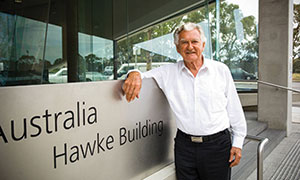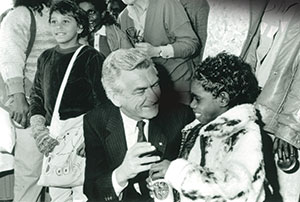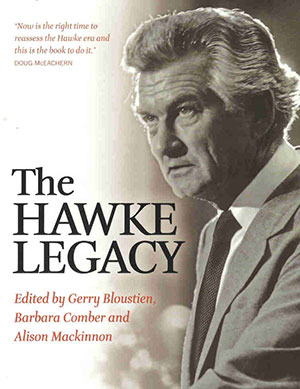The Annual Hawke Lecture was established in 1998 and Hawke delivered the inaugural lecture, A confident Australia. He also attended and often gave the remarks in reply at many of the annual lectures across the following 20 years.
In 2001, Nelson Mandela agreed to become the Hawke Centre’s first International Patron and Hawke helped secure other prominent patrons for the centre, including Dr Lowitja O’Donahue and Sir Zelman Cowan.
 Bob Hawke standing outside the Hawke Building.
Bob Hawke standing outside the Hawke Building.By 2007 the new Hawke Building had opened at UniSA’s City West campus – Hawke had led a funding drive for its construction. The following year he guided and supported the foundation of the International Centre for Muslim and non-Muslim Understanding at the University, pioneering research, scholarship and community engagement to improve understanding and relations across cultures and faiths.
Hawke continued to be closely involved with the Hawke Centre’s program and projects until his death.
His political biographer and senior writer for The Australian, Troy Bramston, says Hawke was “the brightest star in the political galaxy – the most popular prime minister Australia’s ever had, he won four elections, and he left a very big economic, social and environmental legacy”.
“Bob Hawke had a magical political touch,” Bramston says. “He said he loved the Australian people and the Australian people loved him back. I think that was the basis of his political success over a long period of time – that he did have that relationship.
“He was someone whose temper and tears, his emotions would often be on full technicolour display and Bob never hid any of that … he would be very happy in hindsight for people to reflect on his full life, his strengths and his weaknesses, because he never pretended to be something that he wasn’t.”
UniSA Vice Chancellor Professor David Lloyd says Hawke’s contribution to Australia has been nation-building.
“Bob had a formidable intellect but that was framed by a genuine connection with and understanding of everyday people and the practicalities and challenges in their lives,” Prof Lloyd says.
“At UniSA we will remember his generosity, his dedication to The Bob Hawke Prime Ministerial Centre, and his efforts to support research into interfaith and intercultural understanding.
“We will also remember his warmth, his incisive intellect, his wit and humour and his enduring capacity to bring people along, to help them think in new ways and to build understanding.
“These are the qualities – intelligence, humanity, scholarship and understanding – that we undertake to nurture in honour of this truly great leader, through the work of the Centre that carries his name.”
Over the following pages, UniSA researchers write about Hawke’s legacy in key policy areas to provide insights into the very real progress made during the Hawke era.
A fair go, a say and a choice for women
By UniSA School of Creative Industries Emeritus Professor Alison Mackinnon AM
Recently Susan Ryan, Labor’s first female minister, wrote “women of Australia, be grateful for what Bob Hawke did”i. Why should we be grateful? The reasons are legion. Drawing on the 1970s women’s movement and the determination of key ministers, notably Susan Ryan, groundbreaking legislation, The Sex Discrimination Act of 1984 and the Affirmative Action (Equal Opportunity for Women) Act of 1986, was put in place under the Hawke government. This continues to have a powerful effect in Australian society, protecting women against all forms of discrimination.
The legislative initiatives shaped the way forward for years to come and gave women the tools to argue against discrimination on the grounds of sex, marital status, pregnancy, potential pregnancy or family responsibilities or involving sexual harassment. It also mandated the agencies to put the ideas into practice.
Those Acts have been considerably amended over the ensuing years but remain centrepieces of gender equality. However, Hawke’s influence for women goes well beyond that legislation. His government delivered unprecedented progress in the economy, in education, employment and in providing opportunities for Australian women. Programs such as the Participation and Equity Program, which aimed for universal participation in senior secondary education, is credited with increasing school retention rates from just over 30 per cent in 1981 to almost 80 per cent by 1991. Girls were key beneficiaries of this program. Of similar benefit to women were issues such as universal health insurance, cash payments to families, child support and growth in TAFE and higher education. There was a strong movement of women into the trade union movement at that time. Specific policy in relation to Indigenous women was introduced and laws to protect migrant women and women with a disability. The needs of older women were addressed through pension reform and changing dependent spouse tax rebates for their husbands into cash payments for the women themselves. Many of these changes were highly controversial and required Hawke’s famed skills at consensus and his support for ministers such as Susan Ryan.
In March 1987 Hawke presented to parliament the report of the consultations on the National Agenda for Women. The National Agenda for Women was to be the foundation on which policies to realise those expectations would be planned and built up to the year 2000. While not all of the ambitious agenda was met, Hawke and his cabinet went a long way towards ensuring women would have “a fair go, a say and a choice”.
i The Guardian, Australian edition, 16 May 2019.
Medicare – a legacy of health care
By UniSA Academic Director: Economics, Finance & Property Dr Ron Donato
 Australian Labor Party campaign memorabilia, Bob Hawke Prime Ministerial Library. Used with permission from the Australian Labor Party.
Australian Labor Party campaign memorabilia, Bob Hawke Prime Ministerial Library. Used with permission from the Australian Labor Party.Despite strong electoral support for Medicare, the Hawke Labor government encountered considerable resistance in implementing its health policy agenda. A bitter dispute erupted between the government and the medical profession which was particularly concentrated amongst specialists in New South Wales. It was intervention at the highest political level involving the prime minister himself, together with the NSW premier and the president of the Australian Medical Association (AMA), that finally settled the dispute, more than 12 months after the introduction of Medicare. As part of the consensus approach adopted by the prime minister, a compromise was found in which considerable concessions were made by the federal government to the AMA demands, but the basic principles of Medicare remained intact.
As newly elected Labor Party leader, Bob Hawke was instrumental in ensuring that the proposed Medicare system was accepted as part of the ‘social wage’ by trade unions and represented the centrepiece of the Prices and Incomes Accord. Moreover, adopting a consensus approach, a personal trademark of the Hawke era, was instrumental in ensuring that the Medicare system overcame considerable political resistance following its implementation as well as entrenching it into the Australian socio-political fabric through continued electoral success.
The essential role Bob Hawke individually played to effect this is immeasurable.
Hawke’s torch for Aboriginal rights and education
By UniSA Dean: Aboriginal Engagement & Strategic Projects Professor Peter Buckskin PSM
 Bob Hawke with Kakadu school children. Image Courtesy National Archives of Australia.
Bob Hawke with Kakadu school children. Image Courtesy National Archives of Australia.Between 1983 and 1991, the Hawke government built on Gough Whitlam’s legacy in Aboriginal affairs, progressing Aboriginal self-management and self-determination through practical, representative bodies that could influence government policy more significantly than Aboriginal voices had ever done before.
In the foreword to the 2003 book The Hawke Government A Critical Retrospective, editors Susan Ryan and Troy Bramston noted Hawke’s own recollection: “Concern with equity during a time of economic reform was a reflection of our broader fundamental commitment to creating a society of equality of opportunity and non-discrimination.”
What was important to Aboriginal people was that they and their representatives on both the National Aboriginal Education Committee (NAEC) and the Aboriginal and Torres Strait Islander Commission (ATSIC) were being encouraged to discuss issues such as autonomy and self-determination and their advice on improving Aboriginal wellbeing was forming the basis of government policy.
Hawke’s commitment to consensus, to seeking out leaders in various sectors and securing consensus around major issues, was being applied to Aboriginal education and for the first time ministers had confidence in us. We responded with energy and hard work.
By supporting the work of Susan Ryan and John Dawkins to improve Aboriginal education, and particularly by launching the 1989 National Aboriginal and Torres Strait Islander Education Policy, Hawke displayed leadership and humanity which gave Aboriginal leaders and educators the confidence to continue to speak out for their people. By supporting the NAEC, he created an environment where Aboriginal leaders developed networks and community support structures that delivered hope and began a process which would ensure that the Aboriginal voice would be heard right across the nation.
Bolstering equity in education
By UniSA School of Education Emeritus Professor Alan Reid AM
The role of education in creating a fairer society was central to Bob Hawke’s world view. It is not surprising therefore that equity was a dominant theme in education policy throughout the period of the Hawke government.
In school education, commonwealth funding was increased and distributed on the basis of ‘need’ with more funding going to the most poorly resourced public and private schools. In addition, the New Schools Policy was introduced to stop new private schools setting up in places where there wasn’t a demonstrated demographic need. This emphasised the centrality of public schools to local communities.
A number of curriculum programs were targeted at those schools and student groups with the lowest retention rates. These included programs such as the Participation and Equity Program (PEP), the national policy on the education of girls, and the national Aboriginal education policy.
Collectively these programs had a real impact, with apparent retention rates to the end of Year 12 doubling to nearly 80 per cent during the years of the Hawke government. Significantly, retention rates increased for girls, Indigenous students, and students from low socioeconomic backgrounds – although there was still much work left to do to ‘close the gap’.
The Hawke government also helped to create a coherent national rather than state-based approach to school education. For example, it established a national curriculum agency, achieved agreement on national goals for schooling, and initiated Australia’s first serious attempt at a national curriculum.
In the end the latter draft document was not accepted by the states, but the process altered the educational landscape and presaged Australia’s first national curriculum 20 years later.
Lighting the way for a multicultural Australia the way for a multicultural Australia
By Centre for Islamic Thought and Education Professor Mohamad Abdalla
I have always admired Prime Minister Bob Hawke because of his policies.
I met him in March 2007 at a three-day deliberative poll, exploring the relationship between Muslim and non-Muslims in Australia, where he gave the keynote at the dinner.
He spoke about the shared civilisational heritage between Islam and the West, the need to resolve the Palestine-Israel conflict – it was inspiring, and it was timely.
I met him a few times since to discuss how to best improve relations between Muslim and non-Muslim Australians, something he believed was vital for our future harmony.
In 2008, he championed the launch of the International Centre for Muslim and non-Muslim Understanding at UniSA. Its research focused on critical engagement and dialogue at a local, national and global level, including Muslim, non-Muslim relations, a commitment to reconciliation and to developing rational approaches to overcome prejudice and embrace diversity.
He returned to UniSA to launch the Centre for Islamic Thought and Education (CITE) in 2016. In his address, he emphasised the value of multiculturalism and the shared heritage.
Hawke believed in and advocated for multiculturalism. In 1987 he established the Office of Multicultural Affairs (OMA) in the Department of the Prime Minister and Cabinet – putting it at the heart of government business.
The success of Australian multiculturalism was largely due to his vision and his passion for inclusion.
The National Agenda for a Multicultural Australia, launched in 1989 and developed by his Department of Prime Minister and Cabinet, received bipartisan support.
The Agenda presented a definition of multiculturalism and outlined eight goals including “cultural identity” – stating that all Australians have the right to express and share their individual cultural heritage, including their language and religion.
Hawke’s commitment to multiculturalism was dramatically reinforced after the events of the Tiananmen Square massacre. On 16 June 1989 when, in an emotionally charged speech, Hawke extended all temporary entry permits for Chinese nationals legally in Australia for 12 months, including work rights and financial assistance, he acted on his values and beliefs.
It was one of many moments when Hawke’s humanity – his capacity to imagine other people’s dilemmas and act with integrity to support them – came to the fore.
Some 42,000 Chinese were granted permanent visas – this, according to Australian National University’s adjunct Associate Professor James Jupp, “broke the back of remaining support for white Australia”.
Hawke’s living legacy
 Book cover: The Hawke Legacy
Book cover: The Hawke LegacyThe Bob Hawke Prime Ministerial Centre and Bob Hawke Prime Ministerial Library are living legacies of the work of Bob Hawke.
Through its public program, the Centre ensures the issues Hawke cared most about – education, reconciliation and Australia’s evolution as a civil and just society – are in the public arena.
The Bob Hawke Prime Ministerial Centre attracts audiences of almost 50,000 a year who attend an average of 65 lectures and exhibitions devoted to contemporary political and social issues and cultural development. More too, tune in to the recordings of these events.
The Annual Hawke Lecture regularly attracts more than 1000 people.
Director of the Centre, Jacinta Thompson, says former Prime Minister Bob Hawke was dedicated to the notion of education through public engagement.
“In his honour, our program of events has always been about giving anyone who wants to attend the chance to learn more, to hear about current issues from people who have the knowledge and experience to teach us more,” Thompson says.
“Our focus is the wider community and we are devoted to generating ideas and solutions to achieve more cohesive, sustainable societies – it is a vision of stability and humanity that was close to Bob’s heart.”
This year, The Bob Hawke Prime Ministerial Library received 300 new boxes of archival material relating to the former Prime Minister, his life and leadership. The boxes contain a wide range of materials including clothing, memorabilia, sporting goods, cards and correspondence, speeches post his time in office, video recordings, photographs and slides, gifts from dignitaries and everyday Australians, diplomatic passports and daily schedules of Hawke’s activities from 1983 onwards.
The collection at UniSA already includes 64,200 individual items arranged in 321 Archival Containers and processed into series and folder records with an estimated 200 items per archival box.
There are almost 4000 individual items that have been digitised and associated records created including speeches, photos and photos of realia. All are available via the UniSA library catalogue.
In the past 12 months the number of research enquiries to the library have more than doubled.
According to author and biographer Troy Bramston, the Bob Hawke Prime Ministerial Library holds “one of the truly great prime ministerial collections we have in this country”.
“It’s a vast collection and Adelaide and Australia are very lucky to have it,” he says.
The collection includes ACTU reports, parliamentary papers, handwritten notes, policy documents, political polling and historical memorabilia such as Australian Olympic team tracksuits, campaign t-shirts, the wedding clothes worn by Hawke and Blanche d’Alpuget in 1995, Hawke’s school report cards, diaries and notebooks and childhood drawings he made for his parents.
The first Australian prime ministerial library to be established during the lifetime of the prime minister concerned, it has benefited greatly from Hawke’s patronage and the items he and his former colleagues have donated to the collection.
Located in purpose-built research and archival facilities in the landmark Hawke Building at UniSA’s City West campus, its key role is to describe and manage a unique collection of scholarly and research materials and memorabilia.
Manager of academic library services, Jane Angel, says a core responsibility for the library is to provide researchers, historians and students access to the resources.
“This is a really rich collection because it includes the most personal items and also materials related to some of the most public events and issues that involved the former Prime Minister,” Angel says.
“We have in the collection a reflection of his life, his times, his wisdom and his challenges.
“That gives us, as keepers of the collection, a great opportunity to interpret and highlight the important themes of the Hawke era in public exhibitions, online presentations and education displays. That is certainly a very special role the library will play in keeping alive Hawke’s legacy in Australian history.”
See the full Bob Hawke Timeline online.